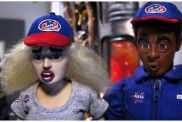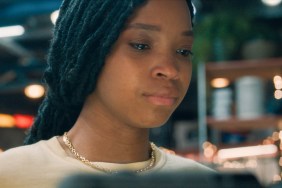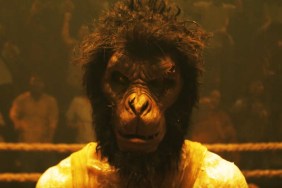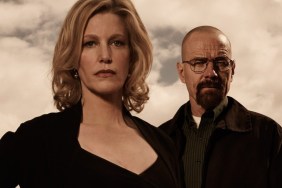Any time in the last twelve years, Steven Soderbergh would be considered one of the most prolific filmmakers in the country, often releasing two movies in any given year, which is why just four months after his viral thriller Contagion was released, he’s back with the action-thriller Haywire.
Haywire pairs Soderbergh with Mixed Martial Arts (MMA) champion (and former “American Gladiator”) Gina Carano playing Mallory Kane, a freelance special agent who learns there’s a target on her back, possibly even by her own employers, when a job goes wrong. Her immediate superior (and former boyfriend), played by Ewan McGregor, doesn’t seem to know anything about why people are trying to kill her, but in the course of trying to find the answer, Mallory must take on a bunch of equally-skilled killers, including ones played by Channing Tatum and Michael Fassbender. The cast is rounded out by Michael Douglas and Antonio Banderas as two behind-the-scenes players further up the chain.
Like Soderbergh’s earlier work with porn star Sasha Grey in The Girlfriend Experience, it’s pretty gutsy to base an entire film around someone who has never acted a day in their life (at least in the mainstream movie world). Haywire is definitely more mainstream in the sense of having connections to both modern action films like the “Bourne” series and older conspiracy thrillers from the ’60s and ’70s. Even so, Soderbergh’s artistic sensibilities come to the fore quite often over the course of the film in terms of the way things are filmed and edited, which makes Haywire quite unique.
Soderbergh is one of our favorite directors to interview, partially because he insists on doing longer form interviews with anyone who speaks with him and as someone who constantly faces not having enough time, usually 10 to 15 minutes, to fully get into a conversation, we loved having extra time with Soderbergh. We ended up speaking to him for roughly 45 minutes and because it all was good and interesting, we’re going to run every single bit, though we’re going to break it up into a couple pieces as to not take our readers away from other important things for too long.
In Part 1 (below), we’re sticking pretty much with Haywire, but in Part 2, we’ll talk more generally about the industry and Soderbergh’s relationship with writers, acting collaborators, awards and the MPAA.
ComingSoon.net: I’m curious about the origins for “Haywire.” Was it born out of the desire to do an action movie or did it always start as a desire to work with Gina Carano?
Steven Soderbergh: Yeah, it was really a very random sequence of events. I literally was just channel-surfing one night and landed on this thing TBS had for a while where they were doing MMA fights on Saturday primetime. She just happened to be fighting, and I just thought, “Wow, she’s cool.” When they interviewed her, she seemed to be pretty together. I just sort of filed that away in the back of my mind, and then another thing that had been filed away in the back of my mind was my desire at some point to make a sort of ’60s-style spy movie, but in a very kind of human scale, more like the Harry Palmer films with Michael Caine than the Bond films. It was just kind of a vague notion, and I hadn’t really taken any steps to pursue it or talk to anybody about it; it was just one of those things that I would think every once in a while, “Wow, it’d be cool to make a movie like that.” So, in June of ’09 when “Moneyball” imploded and I was looking for something to do quickly because I had a whole group of people that thought they were going to be working, I called (producing partner) Greg Jacobs and I said, “Look, what if I combined this one idea with this woman, and we try and go make something quickly that’s on a sort of manageable scale within this vein?” He’s like, “Well, call her up.” I think it was almost the same week she had just lost her last fight, so I took the train down to San Diego to talk to her, and sorta described to her what I was thinking and just basically said, “Are you up for the idea of me kind of building a movie around you in which we kind of reverse engineer it to augment what you can do and who you are?” She said, “Yeah, that sounds like the perfect antidote for me right now.” Then we went to Relativity and pitched it, and they said, “Look, we love her. We love the genre. If you can get some great talent around her, then we’re in.” Fortunately, we were able to do that.

CS: Did you have a lot of the cast together even before Lem started writing?
Soderbergh: No, that’s hard to do. (Laughs) The good news was that as soon as I finished meeting with Gina I called Lem, so we were already working, and the script came together very, very quickly. He had a draft in like five weeks. We were able to sort of bring the cast together pretty quickly, so that helped.
CS: Was your first meeting with Gina at all like your first meeting with Sasha? Did you have an idea right away that she could carry a movie and keep the audience interested for 90 mimutes?
Soderbergh:Yeah, I mean, I guess all that I wanted, all that I needed was that there was no affectation, that I was dealing with somebody who really was who they appeared to be and wasn’t kind of living in the third person and performing in real life. I needed to be sure that there was just a genuine quality and a sincerity and in both those cases, that’s what I felt when I met them. I knew as long as I have that, I can make sure that I design something that will bring that to the foreground. I knew after talking to Gina, God, if I can capture that, then we’ll be in good shape.
CS: I’ve never seen her fight but she has a great personality and really does carry the movie with lots of different layers, so did she meet Lem as well or did they work together to develop the character?
Soderbergh: As soon as she said “yes” and the movie was greenlit, I sort of threw her at our technical advisor, Aaron Cohen, because I felt like there is no better training for her than the kind of training he’s going to put her through, which is to make her think like one of those people. She went through a three-month really intense surveillance counterterrorist training program with Aaron, and when she came out the other end of it, she really felt what it was like to be one of these people, and that helped a lot.
CS: Between “Traffic” and “Contagion” you’ve dealt with a lot of diferrent government agencies, so was this type of counter-terrorism mercenaries something you learned about from doing research for other movies?
Soderbergh: No, it kind of came about because I knew I wanted her to work in the private security world because I found that to be a really interesting aspect of what’s going on in the world now. Then once we found Aaron Cohen, whose specialty was counterterrorism and surveillance techniques–and he was in on a lot of the conversations with Lem and I about how that world works–what kind of people are in it, how much do these jobs cost, what do people get paid? How do they talk? All that. What kind of weapons do they carry, what does this stuff look like? He was very helpful in sort of answering the question that I always asked no matter what movie we’re working on, which is, “Well, what’s real? What really happens? Let’s start there.” He was a great person to have around because he knew.
CS: With “Contagion” you worked with Scott Burns who did a ton of research for that. Do you yourself feel you have to be as knowledgeable about everything as anyone else and be able to answer any questions anyone might have before you start?
Soderbergh: Well, it’s strictly a matter of invariably, there’s good stuff there. Like, nine times out of 10 you can’t make up something that’s as good as what’s actually going on, so I just feel it’s part of your homework. I feel that if you have this job, this should be part of your homework to educate yourself just so you know what the hell you’re talking about. Like I said, most of the time you don’t have to make it up. It’s all there already. Somebody’s already experienced this.
CS: Since you do your own camerawork, when you knew you would have action based around MMA moves, how did you approach choreographing the fights and how to shoot them?
Soderbergh: I knew going in that I didn’t want to do it the way most of that stuff is being put out, but because we were dealing with a lead actor and supporting actors who could really fight and pull it off, that I wanted the visual approach to not get in the way of you looking at it and saying, “Sh*t, that’s really happening.” The camera is not hand-held, there are fewer cuts. I’m usually pretty loose on them. I rarely go in tight, and when I do go in tight, I don’t go in so tight that you don’t know where you are, and there’s no music.

CS: Many Hollywood directors when making martial arts films will allow the stunt choreographer to DP their own fight sequences since they know where to place the camera so it won’t accidentally get trashed.
Soderbergh: Yeah, right. (laughs)
CS: Did you study a lot of other action movies and how did they impact how you approached this?
Soderbergh: Well, I started looking at people who were doing things in a way that I think are exceptional in terms of staging and cutting, so Fincher, Spielberg, Cameron, John McTiernan, people that have a gift for staging action in the way that I like to see it staged where your geography is clear and the cutting is not manic, so I would just watch that stuff and try and break down why they were doing what they were doing, and to see if I could start to think like that.
CS: What about getting a supporting cast who could go toe-to-toe with Gina? Channing’s obviously done a ton of action, Mike Fassbender, maybe not so much, but I guess he’s pretty athletic guy. How did you prepare them to work with Gina?
Soderbergh: They were excited. I mean, Channing knew who she was, so he wanted to be involved. Yeah, Fass is a very athletic guy, very agile guy, and then we had Obi-Wan Kenobi (aka Ewan McGregor), so they were excited because she’s the real deal and they wanted to be a part of that.
CS: There’s also something kind of arty about some of the action scenes like the flashback to Mallory’s job that went wrong, which reminded me of the ’60s thrillers you mentioned before. Could you talk about contrasting that with the more modern-looking MMA action?
Soderbergh: My whole rule is that it has to be real. I don’t want anybody doing anything that a person can’t actually do, so as a result, at a certain point the thing can’t go on forever because you run out of things to do in terms of sequences. Right now, if you put a gun to my head and say, “You gotta make a sequel to this movie,” I don’t know what I would do. I don’t know what else I could make her do.
CS: It’s funny you say that because even though you said you didn’t want to make a Bond movie, Gina’s character Mallory has a quality a bit like Bond or Bourne, so do you think it’s a character that could be featured in more stories and movies?
Soderbergh: Yeah, I guess. (laughs) Like I said, I suppose. I don’t know, maybe she can swim really fast. I don’t know what else
I wouldn’t want to repeat what we did, so I’d have to
I don’t know. Maybe you’d find another women and have two women go at it.
CS: You mentioned not having music in the fighting scenes, but then you have David Holmes, who you worked with on the “Ocean’s” movies, doing the music for the rest of the movie, and he has a style that’s very reminiscent of the ’60s and ’70s. Was this something you figured out fairly early on?
Soderbergh: Yeah, he and I were talking about this composer we both liked, Lalo Schifrin, who did “Bullitt” and who did the original “Mission: Impossible” theme and a lot of other great stuff. It’s kind of very rhythmic, very propulsive, lots of horns, and that’s what I was sort of attempting. I temped the film with a lot of stuff from “Bullitt,” so that was really sort of a jumping-off point. I liked that it wasn’t anything at all like the typical track you’ve been hearing in action movies.
CS: I know you like shooting fast, so is that generally the case when you get to the editing and post-production stage? How does the process of editing compare to the filming?
Soderbergh: It’s usually pretty quick. I mean, it depends. On “Haywire,” I was cutting myself, “Contagion” I was working with Stephen Mirrione, who I’ve worked with before. It really depends on what the piece is. In this case, the movie came together pretty quickly, and then we had this lagtime because of what was going on between Relativity and Lionsgate, so the movie was done and kind of sitting there, and I took the opportunity because we had six months to go in and work on it some more, which was a really fortuitous set of circumstances because I think we improved it. I make choices on the set that are pretty difficult to unwind, so in a lot of cases, it can only go together a certain way. In terms of “Haywire,” structurally there was some wiggle room there. For the first half of the movie you’re in a kind of flashback that finally loops through and catches up with itself, so there are a lot of options about when to go back and forth. We played around with that a bit, but a lot of those sequences, the arc was designed to be put together one way because I made those decisions on the set, which I think is part of your job.

CS: I thought the non-linear way of telling the story was interesting, so that was something developed in the script stage?
Soderbergh:Yeah, we wrote it that way.
CS: When you make a movie, how much of the storytelling is figured out in the editing room? “Contagion” is a good example because there are a lot of stories being told and it could be cut together many different ways even though there is an obvious timeline.
Soderbergh: Yeah, that one there were a lot more moving parts in that. We did a lot of versions of that film and ended up eliminating a lot of material. We had even more storyline, we had a lot of characters, we had technical information. The process of screening that was really important because in a movie like that, it’s really hard to tell what information is sticking with people and what information isn’t. As technical as the movie gets and as sort of airtight as the science is, there used to be a lot more of it, and what we found out was people started tuning out. There was a tipping point where they became overwhelmed and they just stopped paying attention completely, so we had to back off of some of that and make sure. But again, it was kind of trial and error to try and find this balance of enough science to make it feel real and make it feel scary, but not so much that you were going, “Hey man, give me a break.”
CS: So when you make a movie and you’re trying to keep things realistic, is there the danger of making a movie too smart for audiences?
Soderbergh: Yeah, I mean, I think when you’re dealing with a certain kind of material, yeah. That was the case here. Like I said, there were versions where there was just too much technical information, and we were expecting people to sort of assimilate and retain information that a journalist might not assimilate or retain, and we didn’t know that. You just gotta show it to people who are not your friends to figure that out.
CS: Even though “Haywire” is really focused on Gina, there’s still a lot of moving parts. You tend to work with large ensemble casts but in smaller scenes with two or three people. Are doing these movies with big casts and winding stories something you like doing to challenge yourself?
Soderbergh: In this case, even though the movie’s pretty simple, somebody betrays her and she’s trying to figure out why and find them. What was fun was to play with the motivations and the fact that it’s very difficult for her to determine the why of it. I liked keeping that sort of ambiguous. (MILD SPOILER WARNING FOR THIS LAST BIT!) It’s pretty clear that Ewan McGregor’s character is taking the attitude both on a professional and a personal level, “Well, if I can’t have her, then I don’t want anybody to have her,” but the specifics of it are kind of vague because we know they had a relationship, but we don’t know what happened. We just know that she dumped him. (SPOILER DONE)
Later this week, you can read the second half of our interview, in which we talk more generally about things non-Haywire.
You can also read more about Soderbergh’s other upcoming projects Magic Mike, The Side Effects and his Liberace movie “Behind the Candelabra” for HBO here.
Haywire opens everywhere on Friday, January 20.
(Photo Credit: PNP/WENN.com)









